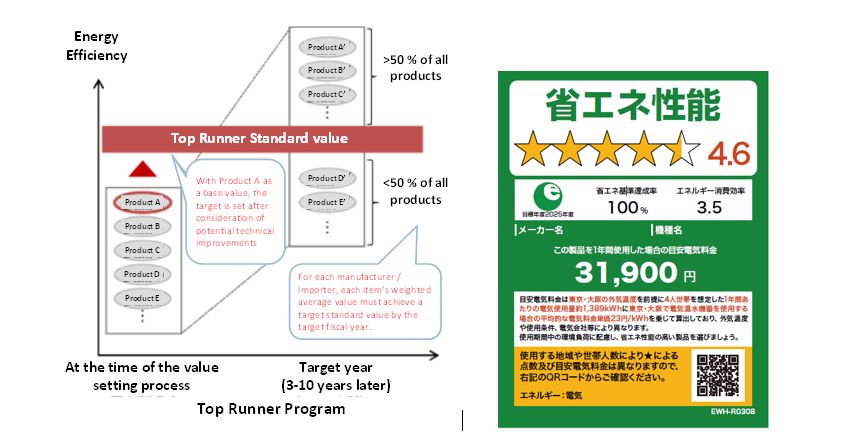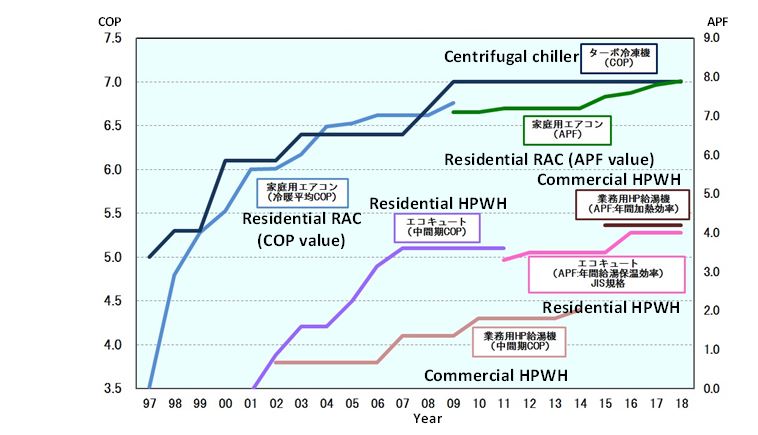The Role of Heat Pumps towards Decarbonization – Japan’s Policy, Market and Technology (2)
Thứ tư, 09/02/2022 - 13:54
The previous article described the outline of Japan’s decarbonization policies, the situation of energy and energy-related policies. Heat pumps are recognized as a key technology to the decarbonization of our country. This article will elaborate Japan’s energy-related policies, market and R&D projects related to heat pumps.
1. Energy efficiency policies for equipment
"Top Runner Program” is an energy efficiency standard system which sets target values of the future based on the value of the most efficient equipment of the moment. For example, as you can see on Fig 1, Product A is the most efficient equipment at the moment. Using this highest efficiency as a base, the standard value of the future is set taking into account possible technological improvements. And this standard will be the target value in the target year which is 3 to 10 years later. And each manufacturer or importer will have to achieve this target as weighted average of their products. Currently, 32 items including heat pumps and boilers are covered by this program.
We also have "The uniform energy efficiency labels". The new labeling for EcoCute heat pump water heaters started in October 2021.

Fig 1. Energy efficiency policies for equipment
(“Top Runner Program” and "The uniform energy efficiency labels")
Energy efficiency of heat pump has been improving as you can see on Fig 2 thanks to the policies. Awards such as the ones by the Ministry of Economy, Trades and Industry (METI) and the Ministry of the Environment (MOEJ) are another driver of energy efficiency of equipment including heat pumps.

Fig 2. Efficiency improvement of heat pumps
2. Subsidies
The government offers some subsidies for the implementation of heat pumps.
- Subsidy for investments for advanced energy conservation project (METI)
This is the subsidy for energy saving projects including heat pumps. Heat pumps are subsidized in several categories shown below. This subsidy is basically aimed at improving energy efficiency in existing premises.
A. Advanced equipment
(e.g., Heat pump desiccant humidity control, centrifugal chiller, showcase, etc.)
B. Custom-made solutions
(e.g., specially designed facility, production line, etc.)
C. Specified equipment
(e.g., air conditioner, industrial heat pump, commercial heat pump water heater, refrigerator, etc.)
D. Energy management system and service
(Specified energy management service and EMS needed for the service)
- Subsidy for high-efficiency heat pumps in industrial and commercial sectors (METI)
The only subsidy dedicated to heat pumps. Industrial heat pumps and commercial heat pump water heaters are not on track to reach the governmental quantitative target as shown in the previous article and the government is promoting these heat pumps by offering this subsidy.
1. Air-source heat pump chiller (for hot water)
2. Circular heating hot water heat pump
3. Hot water heat pump (heat recovery, water-source)
4. Hot wind heat pump
5. Steam supply heat pump
6. Commercial heat pump water heater
- Subsidy for “Net Zero Energy Buildings” (METI and MOEJ)
High efficiency air conditioners, water heaters, BEMS along with lighting and other equipment installed for "Net Zero Energy Buildings” are covered by these subsidies.
3. F-gas policies
Along with energy-related CO2 emissions, F-gas is another significant issue we need to tackle as regards decarbonization. We have two major laws. One is the Ozone Layer Protection Law which aims to control consumption and production of controlled substances in line with the Kigali Amendment to the Montreal Protocol which came into force in 2019.
Another one is the Fluorocarbons Emission Restraining Law which aims to control emissions over the lifecycle of Fluorocarbons, like management, inspection, reporting, reduction of leakage, proper collection at the time of disposal, etc. as shown in the chart below.

Fig 3. Fluorocarbons Emission Restraining Law
4. Market
Thanks to its efficient nature and favorable energy efficiency policies, the heat pump market seems stable in Japan.
4-1. Residential Room Air Conditioners
The annual sales of residential room air conditioners is around 10 million units. The sales is on the rise due to growing needs of room-by-room air conditioning and due to growing concerns about heat strokes of elderly people.

4-2. Commercial Packaged Air Conditioners
The sales of commercial packaged air conditioners are stable at around 800,000 units annually. The surge in sales in 2019 might be attributed to the demand for 2020 Summer Olympics, which was held in 2021 in reality.

4-3. Residential HPWH (EcoCute)
The sales of residential heat pump water heaters called "EcoCute" are also stable at around 500,000 units annually. The cumulative sales will reach 8 million units in spring 2022 at this rate.

4-4. Commercial HPWH
The sales of commercial heat pump water heaters are around 3,000 units annually. We need to triple this number in order to
achieve the government's target by 2030.

5. R&D
We are actively conducting R&D projects on such as Low-GWP refrigerants and high temperature heat pumps nationally as well as internationally under the framework of Technology Collaboration Programme on Heat Pumping Technologies (HPT TCP) by IEA.
As this article and the previous one discussed, heat pumps will play an indispensable role towards Japan’s decarbonization by 2050. Thanks to its efficient nature and favorable energy efficiency policies, the heat pump market seems stable. Further implementation of heat pumps is required especially in the industrial sector and for commercial and residential hot water production. We are also actively conducting R&D’s.
We’ll make the most of this technology in order for Japan to achieve Net Zero 2050.
By HPTCJ
- Top Runner Program: Ministry of Economy, Trade and Industry (JP)
- The uniform energy efficiency labels: “Japan's ENERGY 2020”, METI
- Efficiency improvement of HPs: Heat Pump and Thermal Storage Technology Center of Japan (HPTCJ) (JP)
- Subsidy for investments for advanced energy conservation project: Sustainable open Innovation Initiative (JP)
- Subsidy for high-efficiency HPs in industrial and commercial sectors: Sustainable open Innovation Initiative (JP)
- Subsidy for “Net Zero Energy Buildings” (METI): Sustainable open Innovation Initiative (JP)
- Subsidy for “Net Zero Energy Buildings” (MOEJ): Shizuoka Environment Resources Association (JP)
